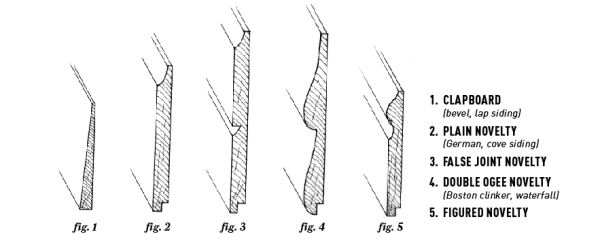Lap siding. Illustration: Rob Leanna
One façade of this Oregon bungalow had original wood Dutch lap siding underneath a composite cover-up, which the owners replicated during restoration. So-called Dutch lap siding is also known as German siding or coved lap siding; it is distinguished by a hollowed reveal (or channel) that produces deep shadow lines. On the bungalow, a narrow exposure keeps the look neat. Coved siding was popular by the 1880s.
Dutch lap or German siding is a type of drop siding, which unlike clapboards is non-beveled and not lapped in installation. Instead it is edge-matched with a shiplap or, less often, tongue-and groove so that it installs flat on wall framing, even without sheathing. The exposed face can be (and has been) milled in a large variety of patterns, thus its alternate name, novelty siding. Economical drop siding is seen on barns and garages but also on informal house types of the early 20th century. The pattern provides good weather protection and the boards install easily.
Novelty siding that uses a bevel (angled)instead of a cove (rounded) is sometimes called channel rustic siding. Another drop siding subset is double ogee, where a single siding board is milled to mimic the shadow lines of two boards. The idea was used for other patterns (double coves, for example), and in some places was even milled as triple ogee. Joints were usually shiplap, sometimes tongue-and-groove. Double-ogee siding was common by 1910.
Rustic siding is milled so that the appearance is of greater thickness. Log-cabin siding is a half-log lookalike. Dolly Varden is bevel siding with a rabbeted edge, allowing installation flat on the wall with a tight joint. When milled with an unplaned face, it’s quite rustic. This type dates to the 1930s or earlier.
Clapboards are the old New England staple: plain lap siding beveled to be thinner at one edge viewed from the end grain. Clapboard is always installed over wall sheathing. Traditional New England clapboard is cut radially from the log, producing true vertical grain that makes it weather resistant and stable. Bevel siding and so-called bungalow siding (alternately known as Colonial siding in some areas) are early 20th-century versions generally resawn from boards (thus producing random grain) to obtain widths of eight inches or more.
Weatherboards, wider than clapboards and common in the Southeast, are lapped like clapboards but usually rectangular and may incorporate a bead. Non-beveled weatherboards also are sometimes called Colonial siding.
During the Industrial Revolution, steam-powered millworks made it possible to create siding in all sorts of patterns to satisfy Victorian builders. By the 1930s, standard references listed no fewer than 28 different types of common horizontal siding. You can still find beveled, drop, and other “novelty siding” at lumberyards, but it’s not always like the original. When repairing or replacing historic siding, take a sample to the lumberyard or sawmill for comparison. Sometimes it’s possible (and usually cheaper) to adapt a local product rather than have an exact match milled. If you decide on custom milling, look for a place that has cutter blades the right size and shape. Otherwise you’ll have to pay for new knives as well as the siding.







